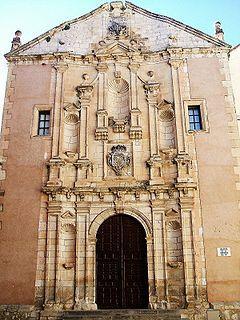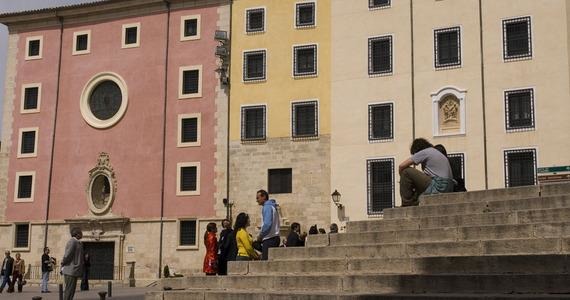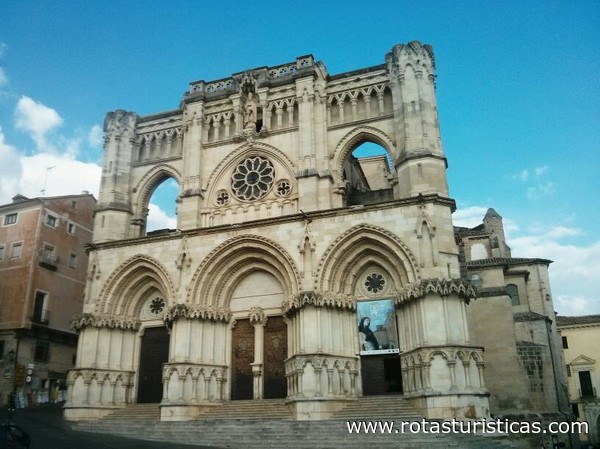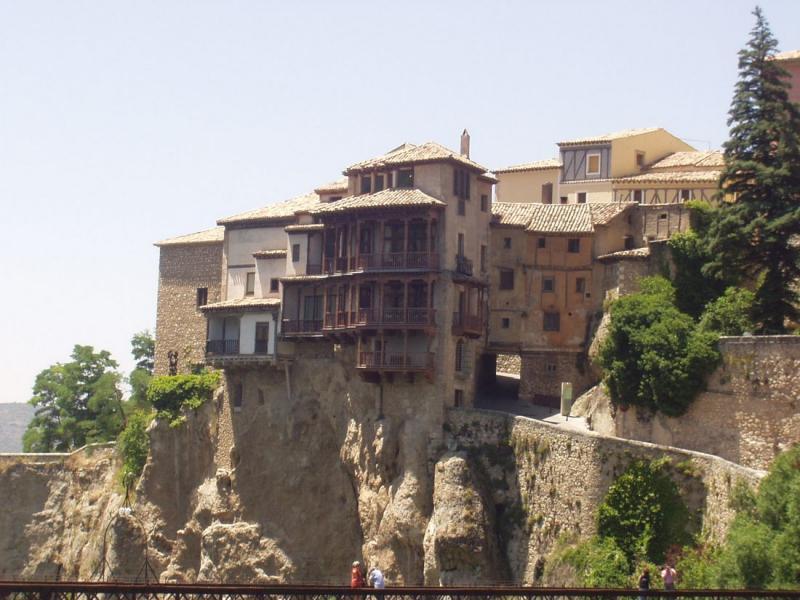Cuenca, Castilla-La Mancha, Spain
Suggest Place to Visit
4390
Track to location with GPS |
 |
One of the best-preserved medieval cities in Spain, a World Heritage city, Cuenca is located as the gateway to the Cuenca Mountains between the gorges of the Júcar River and its tributary, the Huécar.
Prehistory and ancient history
The history of Cuenca is, to a large extent, to be done. Strabo, Pliny and Ptolemy inform us that the first inhabitants of this region were Celtiberian Beribraces called Olcades. Since the Iron Age there have been civitas, castros or polis in different parts of the province (Urbicua, Cartala Egelasta, Contrebia, Belgida, Caraca, Alaba, Condabora, Istonium, Libana, Urcesa, Segóbriga, Ercávica, Valeria ...) but not There is evidence that in the current Cuenca location there would have been some settlement, the closest was Bursada, in the Pinar de Jábaga area where Aníbal subdued them and deported them to North Africa, taking their place the Carpenters.
Ancient pre-Roman city of Lobetum made up of Celtiberians from the Lobet and Olcades tribes.
Medieval history
Although its foundation is not clear, the city of Kunka already existed in 784, its flourishing has to do with the construction as a fortified city, taking advantage of the defensive geographical conditions of the sickles, one of the bases of the Banu Di family. l-Nun, [5] whose power was centralized in the kura (administrative region) called Santabariya (Arabized Celtiberia and Castilianized Santaver). They built a square dependent on the Caliphate of Córdoba in the purest Andalusian style with a castle in the highest area, a medina with its Aljama mosque in the place that today occupies the cathedral and a citadel all separated by moats carved in the living rock and fortified with walls; At the mouth of the river Huécar they built a large pond to increase the defensive system of the city. The first military governor on record was Sulayman ben Utman, killed in 768 by the schoolmaster Sakya ibn Abd al-Wahid, who declared himself in rebellion against the Umayyad troops of Abd al-Rahman I. Hilal al-Madyuni is appointed governor in 772, facing the Berbers of Valencia, for which he was deposed and sent to Córdoba as a hostage in 781.
Emir Muhammad I appointed Sulayman ben Tawril governor, dying in 887, his son Musa took over the government and with 20,000 men conquered Toledo and remained independent until his death in 908. His grandson Yahyá was governor and lord of Uclés until 933 His son Fath succeeded him until 936, being dispossessed of the domain of Uclés and in compensation appointed governor of the Madrid square. Abd al-Rahman al-Midras enjoyed the trust of al-Mansur granting him the caliph the honorary title of "Nasir al-Dawla" being the architect of the enthronement in Toledo of his son Ismael al-Zafir in 1025, his son Al- Mamún de Toledo formed the most extensive and cult of the Taifa kingdoms, annexing the kingdoms of Valencia and Córdoba, dying in 1075. His son Ismaíl served as prince of Cuenca from 1049.
Ivory box, made in the Cuenca workshop around 1050. Louvre Museum.
In 1076 the Aragonese Sancho Ramírez encircles the Plaza de Cuenca without being able to conquer it. In 1080 Yahyá Al-Qádir loses Toledo and the worthy Saíd ben al-Farach takes him refuge in Cuenca celebrating the famous Pact of Cuenca by which Alfonso VI receives Zorita and other castles in exchange for military aid. Coins are also minted. In 1088, the Cuenca military leader ben Zennun made an agreement with the king of Zaragoza, Al-Musta'in II, to hand over the fortress of Segorbe in exchange for military aid against the siege imposed on Al-Qádir in Valencia. As a consequence of the defeat of Alfonso VI in Sagrajas, the Sevillian king Al-Mu'tamid took advantage of the opportunity to take over Cuenca, but in 1091 the Almoravids attacked Seville and King Al-Mutamid sent his daughter-in-law, Princess Zaida, asking for help from Alfonso Alfonso. offering in exchange, for his care and custody, the city of Cuenca among other places. In 1093 a detachment of Christian troops entered. In the vicinity of Cuenca Álvar Fáñez is defeated in the summer of 1098 by the Almoravid general Ben Aisa. In 1108 Cuenca came under the control of the Almoravids and in 1144 the caid Abu Muhammad Abd Allah ben Fetah, al Tagri (the border) rebelled, the following year, on May 15, Murcia took and declared independence.
Mangana Tower, built in the 16th century, whose name is due to the fact that it is the one that carries the clock.
In 1147 Muhammad ben Abd Allah ibn Said ben Mardanís, the so-called King Wolf or Ben Lope, is proclaimed king of Cuenca, Murcia, Valencia and the entire eastern part of the peninsula being independent, facing the Almohads until March 8, 1172 when dies, advising his son Hilal that before the unstoppable military advance of these fundamentalists, sign a pact with them. A 17-year-old Alfonso VIII near the city but after five months of siege the caliph Abu Yaqub Yusuf comes to the aid of the people of Cuenca, forcing the Castilian to flee. The caliph Yucub, the philosopher Averroes, the historian Sahib al-Sala (gives a detailed description of Cuenca) and other notable Almohads enter the city and help the oppressed. Abu Yacub Yusuf and Alfonso VIII signed truces for seven years, but in the summer of 1176 the people of Cuenca, together with those of Alarcón and Moya, algaged the Christian lands of Huete and Uclés, breaking the pact. Alfonso VIII summons the people of Almoguera, Ávila, Atienza, Segovia, Molina, Zamora, La Transierra together with the Lord of Albarracín Pedro Ruiz de Azagra, Count Nuño Pérez de Lara, Pedro Gutiérrez, Álvar Fáñez, Tello Pérez, Nuño Sánchez, the King of León Fernando and the King of Aragon Alfonso El Casto and the Military Orders of Santiago, Calatrava and Montegaudio and encircle the city on the day of the Lord's Epiphany in 1177. The warden Abu Beka asks the Caliph Yacub Yúsuf for help but He is in Africa attending to other matters and denies help. On July 27, the people of Cuenca made an exit attacking the Christian camp in order to deliver a coup de grace against the king, but they only managed to kill Count Nuño Pérez de Lara. Hunger, diseases and deaths from the continuous attacks of manganas and blunderbuss, force that in mid-September they surrender and surrender the city. The Christian army took the citadel and the castle and, after the Muslim abandonment of the city, Alfonso VIII and his entourage triumphantly entered the city of Cuenca in October, becoming part of the kingdom of Castile since then. Alfonso X the Wise granted it the title of City.
Located at the coordinates, Latitude 40 ° 04 'North and Longitude 2 ° 08' West, the city is divided into two well differentiated areas: the old city, located on a rocky hill bordered by the gorges of the Júcar River to the North and its tributary the Huécar river to the south, the latter flowing into the first in the lower part of the old city, shortly before the so-called Puente de San Antón. To the west and south of the old city, and separated by the Huécar river, the new city extends in a north-south direction. The altitude of the city ranges between 920 meters in the new city and just over 1,000 in the highest part of the old city.
Climatology
Climograph of Cuenca
Cuenca's climate is continental Mediterranean, with cold temperatures in winter and mild in summer, with a significant daily temperature fluctuation throughout the year, more pronounced in the hottest months. Rainfall is more abundant than in its surroundings due to the mountainous orography of the Serranía de Cuenca, which is why it exceeds 500 mm. presenting a minimum of rains in the summer months.
The city of Cuenca is one of the main monumental complexes in Spain, with a great international projection that caused it to be declared a World Heritage Site by UNESCO.
In order to strengthen and enhance its possibilities for cultural and tourist development, it is convenient to set up a Royal Board of Trustees that facilitates the promotion and coordination of activities in which state, regional and local entities directly linked to the city of Cuenca participate.
The city of Cuenca is one of the main monumental complexes in Spain, with a great international projection that caused it to be declared a World Heritage Site by UNESCO.
In order to strengthen and enhance its possibilities for cultural and tourist development, it is convenient to set up a Royal Board of Trustees that facilitates the promotion and coordination of activities in which state, regional and local entities directly linked to the city of Cuenca participate.
Religious Music Week (Theater-Auditorium, Church of San Miguel and San Pablo) 969 23 27 67
Encounters with Jazz
Gregorian singing and classical music cycles
Private Handicraft Fair (Equestrian Enclosure)
Nature and Environment Fair: Naturama (Equestrian Venue)
Film Week
World Music Festival
Folkloric Festival (San Julián Park)
Gastronomic Week (Parador de Turismo, San Nicolás Restaurant, Mesón Casas Colgadas)
The days of the Dance
book Fair
Comments
We don´t have yet any comments about:
Cuenca
Cuenca
Be the first to leave a comment as it is very important to inform other people
Outros locais a visitar
Within a radius of 20 km from:Cuenca
Convent of la Merced (cuenca) |
| 0,6 Km |
 |
Museo de las Ciencias de Castilla La Mancha |
| 0,7 Km |
 |
Plaza Mayor (Cuenca) |
| 0,8 Km |
 |
Cuenca Cathedral |
| 0,8 Km |
 |
Santa María and San Julián de Cuenca Cathedral |
| 0,8 Km |
 |
Museo Fundación Antonio Saura |
| 0,9 Km |
 |
Ermita de Nuestra Señora de las Angustias |
| 1,1 Km |
 |
Hotel reservation near Cuenca within a radius of 20 km
Why to book with TRAVEL CLUBE
The best prices
Our partnerships with the world´s largest operators offer research on the best market prices.
More options
At Rotas Turisticos you can book the hotel, buy the air ticket, book the transfer from the airport to the hotel and vice versa, book the local excursions, rent the car, take travel insurance and consult the places to visit and where to go.
Holiday Tips & Destinations
Hundreds of holiday destinations with all the options that allow you to easily choose the destination that best suits your dream vacation.
TRAVEL CLUBE
Links






